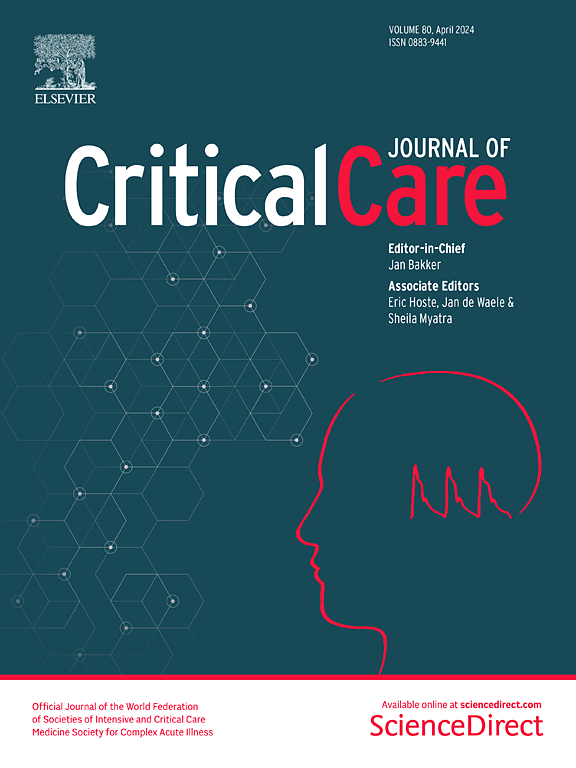INTOXICATE 研究:前瞻性观察研究的方法和初步结果
IF 8.8
1区 医学
Q1 CRITICAL CARE MEDICINE
引用次数: 0
摘要
目前,重症监护病房(ICU)尚未建立以实践为基础的中毒患者多中心数据库。INTOXICATE 研究得到了 ESICM 和 EAPCCT 的支持,旨在确定急性中毒成人重症监护病房患者的事件性入院率。这项多中心、前瞻性观察研究已获得伦理批准,并与各参与中心签署了数据共享协议。研究采用电子病例报告表收集患者的人口统计学数据、接触情况、临床特征、检查、治疗和院内死亡率数据。主要研究结果 "入院事件 "是一项综合研究结果,其定义为患者在入住重症监护病房后的 24 小时内接受以下任何一种治疗的比例:FiO2 > 40% 的氧气补充、机械通气、血管加压、肾脏替代疗法(RRT)、心肺复苏、解毒剂、主动降温、液体复苏(> 1.5 L 的各种静脉注射液)、镇静或在医院内死亡。共有 78 家重症监护室参与了这项研究,其中主要来自欧洲,也有来自澳大利亚和地中海东部的重症监护室。在 2020 年 11 月至 2023 年 6 月期间,共有 2273 名患者参与了这项研究。患者的年龄中位数为 41 岁,72% 的患者接触过麻醉药物。观察到的重症监护室入院患者事件发生率为 68%(n = 1546/2273)。住院死亡率为 4.5%(n = 103/2273)。绝大多数患者都能存活,约三分之一的患者在因急性中毒入住重症监护室后没有接受任何重症监护室特定的干预措施。该研究从一大批急性中毒重症监护室患者中收集到了高质量的详细临床数据,为需要入住重症监护室的严重急性中毒模式以及这些患者的预后提供了信息。试验注册:OSF 注册编号:osf.io/7e5uy。本文章由计算机程序翻译,如有差异,请以英文原文为准。
The INTOXICATE study: methodology and preliminary results of a prospective observational study
There is currently no practice-based, multicenter database of poisoned patients admitted to intensive care units (ICUs). The INTOXICATE study, endorsed by the ESICM and EAPCCT, aimed to determine the rate of eventful admissions among acutely intoxicated adult ICU patients. Ethical approval was obtained for this multicenter, prospective observational study, and data-sharing agreements were signed with each participating center. An electronic case report form was used to collect data on patient demographics, exposure, clinical characteristics, investigations, treatment, and in-hospital mortality data. The primary outcome, ‘eventful admission’, was a composite outcome defined as the rate of patients who received any of the following treatments in the first 24 h after the ICU admission: oxygen supplementation with a FiO2 > 40%, mechanical ventilation, vasopressors, renal replacement therapy (RRT), cardiopulmonary resuscitation, antidotes, active cooling, fluid resuscitation (> 1.5 L of intravenous fluid of any kind), sedation, or who died in the hospital. Seventy-eight ICUs, mainly from Europe, but also from Australia and the Eastern Mediterranean, participated. A total of 2,273 patients were enrolled between November 2020 and June 2023. The median age of the patients was 41 years, 72% were exposed to intoxicating drugs. The observed rate of patients with an eventful ICU admission was 68% (n = 1546/2273 patients). The hospital mortality was 4.5% (n = 103/2273). The vast majority of patients survive, and approximately one third of patients do not receive any ICU-specific interventions after admission in an intensive care unit for acute intoxication. High-quality detailed clinical data have been collected from a large cohort of acutely intoxicated ICU patients, providing information on the pattern of severe acute poisoning requiring intensive care admission and the outcomes of these patients. Trial registration: OSF registration ID: osf.io/7e5uy.
求助全文
通过发布文献求助,成功后即可免费获取论文全文。
去求助
来源期刊

Critical Care
医学-危重病医学
CiteScore
20.60
自引率
3.30%
发文量
348
审稿时长
1.5 months
期刊介绍:
Critical Care is an esteemed international medical journal that undergoes a rigorous peer-review process to maintain its high quality standards. Its primary objective is to enhance the healthcare services offered to critically ill patients. To achieve this, the journal focuses on gathering, exchanging, disseminating, and endorsing evidence-based information that is highly relevant to intensivists. By doing so, Critical Care seeks to provide a thorough and inclusive examination of the intensive care field.
 求助内容:
求助内容: 应助结果提醒方式:
应助结果提醒方式:


